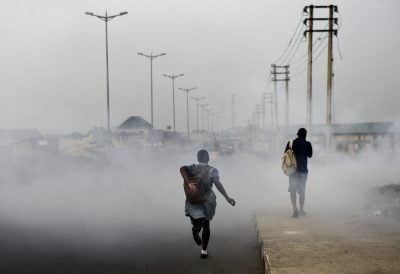After a sharp slowdown mainly caused by the falls in global commodity prices, sub-Saharan Africa finally emerged from an economic slump in 2017.
According to the World Bank, year-on-year economic growth is expected to rise to 2.4% this year, an improvement on the two-decade low of 1.3% in 2016. The growth came as the continent’s three biggest economies – Nigeria, South Africa and Angola, which account for over two-thirds of economic output – finally emerged from downturns. In Nigeria and Angola, the economic climate improved as oil prices strengthened towards the end of the year due to increased demand and supply cuts. Oil prices were expected to average $52 to $53 per barrel in 2017, up 24% from the previous year.
Meanwhile, in South Africa, metal commodity prices and agricultural output improved when compared to the previous year. The recovery in metal prices was due to a tightening of supply mainly in China; and the agricultural sector witnessed a revival due to the drought subsiding. “Africa is continuing to recover but the recovery is a little slower than [the 2.6%] we had projected in April,” says Punam Chuhan-Pole, World Bank lead economist for Africa, in a podcast for the bank.
“The recovery is basically being led by the largest economies in the region including Nigeria, which exited 15 months of negative growth in the second quarter of this year; and South Africa, which emerged from two-quarters of negative growth also in the second quarter.
“So, on the one hand, these economies are seeing somewhat faster growth, but on the other hand the growth that these economies are seeing is really quite weak and below the level that these economies were enjoying between the period of 2010 and 2014.”
While there has been a slight rebound in the three largest economies in sub-Saharan Africa, the rest of the continent has experienced multi-speed growth with some nations lagging behind others. Ethiopia remained Africa’s fastest growing economy, with GDP expected to reach 8.3% this year, despite political instability and the state of emergency which affected parts of the country, and export trade dwindling.
Meanwhile, countries such as Senegal and Tanzania have made significant strides, with growth projected to reach 6.8% and 7%, respectively, this year. However, in the slow lane, the countries of the Central African Economic and Monetary Community, which includes oil exporters Chad, Republic of the Congo and Gabon, have struggled to emerge from the downturn.
Nonetheless, most countries have experienced some level of positivity from the economic climate in 2017, which has helped support increased public spending. “So going beyond the growth experience of these countries, we’re finding that there are some favourable developments in terms of current accounts,” says Chuhan-Pole. “There is a narrowing of current account deficits which is being boosted by commodity prices being higher.
“However, agricultural commodities are struggling in some countries such as cocoa exporter Côte d’Ivoire and that is reflected in the current accounts of those nations,” she added. “But by and large current account deficits across the region are narrowing.”
Despite deficits in some countries narrowing, the level of debt in Africa has continued to rise, especially in commodity-export nations, leading some analysts to warn that the increase is not sustainable.
Rising debt
The growth of sovereign bond issuance in African countries revealed a rebound in lenders’ confidence in commodity-export nations. Nigeria, Senegal, and Côte d’Ivoire, to name a few, sold multiple bonds on the international capital markets in 2017.
However, debt levels in some countries have continued to rise during the last three years, with metals-exporter Niger’s debt-to-GDP surging to over 50% this year. Much of the debt acquired by governments has been borrowed to sure up public expenditure, which has been affected by the weak economic growth in the region.
Across sub-Saharan Africa, the median government debt-to-GDP ratio has risen by 20% or more for the oil exporters and for the region as whole the rate has gone up by 15% in the last four years. The main driver for the increased debt is exchange rate depreciation and the operations of state-owned enterprises, which have significantly weighed down the balance sheets of governments and thrust debt levels higher.
“Debt burdens are rising in some countries, for example in Angola it has reached over 60%,” says Chuhan-Pole. “There is a rise in debt burden which calls for a greater focus on rebuilding fiscal space and looking into issues of fiscal sustainability.”
However, while debt alone is not necessarily a problem, borrowing to support public expenditure is not a viable long-term strategy, according to Abebe Selassie, director of the African department at the International Monetary Fund (IMF).
“Debt in itself is not an issue – the issue is if you can’t service those debts,” Selassie says. “So it is important going forward that governments implement the adjustment plans, such as mobilising revenues, to be able to stabilise debt at its current level.” While the continent’s debt levels have experienced a surge, foreign investment also showed a slight uptick in 2017, especially in countries that have worked to diversify their economies.
Diversification conundrum
Africa’s dependency on commodities as the driver of economic growth has left the region vulnerable to volatile markets which rely on demand in foreign countries that manufacture goods. This dilemma has once again been thrust into the spotlight following the most recent commodities supercycle that was mainly fuelled by increased Chinese demand, and which helped Africa grow by 5% after the financial crisis of 2008–09.
However, that demand has waned and, together with commodity prices being depressed because of oversupply, has led to slow growth across Africa since 2014. Analysts have long argued that governments need to implement a coherent strategy to wean their nations off their dependence on commodities. However, in the majority of cases, very little progress has been made on that front, according to John Ashbourne, Africa economist at Capital Economics.
“A lot of commodity-export dependent nations have been having the same conversation about diversification for a while now, but not enough is being done to implement a coherent strategy,” he says. “However, there are a few countries who have made definitive strides towards diversifying their economies, including Ethiopia and Kenya, and they have increased investment in areas like manufacturing and other value-added areas.”
While some countries have emphasised diversification, the lack of progress in the commodity-export dependent nations such as Nigeria and Angola will continue to drag on the continent’s economic performance. The urgency for commodity-export nations to diversify is further highlighted by the fact that foreign direct investment (FDI) in the last two years has slowed in those countries, and investors are eyeing up non-commodity-export countries in the region.
“The good news is that after a pullback in 2016, bond and equity flows have increased in non-commodity-export countries, which also saw an uptick in FDI,” Chuhan-Pole says. “It’s good to see a return of capital to the region and it also highlights investor sentiment being positive towards a range of countries in Africa.”
As the year draws to an end expect favourable global economic conditions to help continue Africa’s economic recovery, with growth forecasted to reach 3.2% in 2018 and 3.5% in 2019. Despite the positive outlook, the growth will fall short of the headline-grabbing figures seen before the slump.
Taku Dzimwasha
Want to continue reading? Subscribe today.
You've read all your free articles for this month! Subscribe now to enjoy full access to our content.
Digital Monthly
£8.00 / month
Receive full unlimited access to our articles, opinions, podcasts and more.
Digital Yearly
£70.00 / year
Our best value offer - save £26 and gain access to all of our digital content for an entire year!
 Sign in with Google
Sign in with Google 


